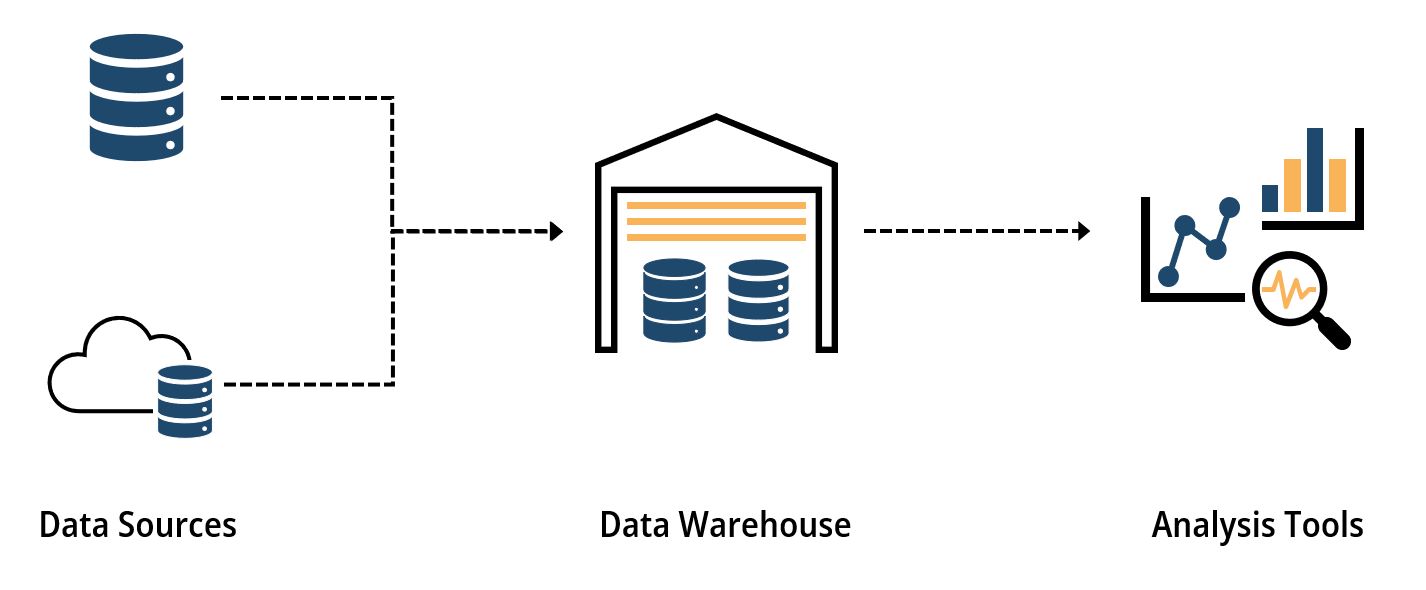What is a Data Warehouse?
As businesses continue to rely on data to inform their decision-making processes, having a comprehensive and accurate view of their data has become more critical than ever. This is where a data warehouse comes in. A data warehouse is a central repository that allows businesses to store, manage, and analyze their data from various sources in a single location. This not only enables businesses to have a single source of truth for their data, but it also provides a solid foundation for advanced analytics and business intelligence.
In this blog post, we'll introduce you to the concept of data warehousing, explain how it can unify multiple data sources into a central database, discuss ETL processes, and explore the business intelligence and analytics possibilities that a data warehouse can enable. By the end of this blog post, you'll have a better understanding of the benefits of data warehousing for your business and how we can help you achieve your data infrastructure goals.
Architecture of a Data Warehouse
A data warehouse is a central repository of all an organization's data, used for analysis and reporting. It's designed to provide a consistent and reliable source of data that can be used to make informed business decisions. The architecture of a data warehouse typically consists of three main components: data sources, data warehouse, and analysis tools.
Data sources are the starting point for any data warehouse. They can include internal systems like ERPs or CRMs, as well as external sources like customer surveys or market data. In order for a data warehouse to provide accurate and comprehensive data, it's important to identify and integrate all relevant data sources.
Once the data sources have been identified and integrated, the data needs to be stored in a data warehouse. This involves transforming the data into a consistent format, which is optimized for analysis and reporting. Data warehouses typically use a star schema or snowflake schema to structure the data, which allows for fast and efficient querying of large datasets.
The final component of a data warehouse architecture is the analysis tools. These are the software applications that are used to analyze and report on the data in the data warehouse. Analysis tools can include everything from simple reporting tools to more advanced business intelligence platforms that allow for data exploration and visualization.
By combining these three components in a well-designed architecture, a data warehouse can provide businesses with a comprehensive view of their data that can be used to inform decision-making, identify new opportunities, and drive growth.
OLAP vs OLTP
In the context of data warehousing, it's essential to understand the difference between Online Analytical Processing (OLAP) and Online Transaction Processing (OLTP). While both are important components of data management, they serve different purposes and are designed to handle different types of data.
OLAP is designed for analyzing and reporting on large sets of data. It's optimized for complex queries and provides a way to summarize and aggregate data to support business intelligence and analytics. OLAP databases are typically read-heavy, meaning that they are optimized for querying rather than inserting or updating data.
On the other hand, OLTP is designed for processing and managing transactional data. It's optimized for handling small, frequent transactions, such as updating customer records or processing orders. OLTP databases are typically write-heavy, meaning that they are optimized for inserting, updating, and deleting data, rather than querying it.
The main difference between OLAP and OLTP is the type of data they are designed to handle. OLAP is designed for analyzing and reporting on data, while OLTP is designed for processing and managing transactional data.
In the context of data warehousing, OLAP databases are used for storing historical data that has been transformed and aggregated for reporting and analysis. OLTP databases, on the other hand, are used for storing current transactional data that is being generated by the business.
Benefits of a Data Warehouse
A data warehouse provides several benefits for businesses, including:
- Single Source of Truth: A data warehouse serves as a centralized repository for all of a company's data, providing a single source of truth for decision-making. This helps ensure that all users have access to the same accurate and consistent data, reducing the risk of errors and inconsistencies.
- Improved Data Quality: By consolidating data from multiple sources, a data warehouse allows businesses to improve the quality of their data. This is achieved through data cleansing and transformation, which standardizes data formats, eliminates duplicates, and resolves discrepancies.
- Faster Query Performance: A data warehouse is optimized for querying and analysis, providing faster query performance compared to traditional transactional databases. This is achieved through the use of indexing, partitioning, and other optimization techniques.
- Easier Analytics and Reporting: With a data warehouse, businesses can easily perform analytics and reporting on their data. This is achieved through the use of business intelligence and analytics tools, which provide powerful visualization and reporting capabilities.
- Data Security: A data warehouse provides enhanced data security compared to traditional transactional databases. This is achieved through the use of access controls, encryption, and other security measures, which help prevent unauthorized access and data breaches.
While these benefits apply to both on-premise and cloud data warehousing, cloud data warehousing provides additional benefits such as:
- Scalability: Cloud data warehouses can easily scale up or down as data needs change, allowing businesses to pay for only the resources they need. This can be especially beneficial for businesses with fluctuating data needs.
- Flexibility: Cloud data warehouses offer greater flexibility in terms of data storage and management, allowing businesses to integrate a variety of data sources and types. This can make it easier to adopt new technologies and data sources as they emerge.
- Cost-effectiveness: Cloud data warehousing can be more cost-effective than on-premise data warehousing, as businesses only pay for the resources they use, rather than investing in costly hardware and infrastructure. This can make it easier for businesses to manage their data warehousing costs and avoid costly hardware upgrades.
- Advanced features: Many cloud data warehousing services offer advanced features such as built-in analytics and machine learning tools, making it easier for businesses to gain insights and drive growth.
- Improved Security: Cloud data warehousing services often offer enhanced security features, such as data encryption, access controls, and automated backups, helping businesses protect their data from unauthorized access and breaches.
Overall, a data warehouse provides several benefits for businesses looking to improve their data management and analytics capabilities. Cloud data warehousing provides additional benefits, including scalability, flexibility, cost-effectiveness, advanced features, and improved security.
Data Warehouse vs. Database
While data warehouses and databases both manage data, they differ largely in the following key points:
- Purpose. A database is designed to manage operational data, such as transactions and records, for day-to-day business operations. In contrast, a data warehouse is designed to store and manage historical data from multiple sources, typically for reporting and analysis purposes.
- Structure. Databases typically use a normalized data model, which is optimized for transaction processing and enables efficient data retrieval and modification. In contrast, data warehouses typically use a denormalized data model, which is optimized for analytical queries and enables efficient data aggregation and analysis.
- Query Performance. Databases are optimized for transaction processing, which requires fast data retrieval and modification. In contrast, data warehouses are optimized for analytical queries, which require complex joins and aggregations.
- Schema. Databases often use a fixed schema, which is defined in advance and enforced through constraints. In contrast, data warehouses often use a flexible schema, which allows for easier integration of new data sources and types.
Databases and data warehouses have different purposes and are optimized for different types of data management and analysis. While databases are designed for real-time transaction processing, data warehouses are designed for historical data analysis and reporting.
Data Warehouse vs. Data Lake
Data warehouses and data lakes are both used for managing data, but they differ in several key ways that reflect their distinct purposes and usage scenarios.
- Data Structure. Data warehouses use a predefined schema to organize data into tables and columns, with a fixed structure that ensures data consistency and accuracy. In contrast, data lakes use a schema-on-read approach that allows data to be stored in its raw form without a predefined structure, enabling flexibility and agility in data analysis.
- Data Types. Data warehouses typically store structured data that can be organized into tables and columns, such as transactional data, customer records, and sales figures. Data lakes, on the other hand, can store structured, semi-structured, and unstructured data of all types, such as social media posts, sensor data, and clickstream data.
- Data Processing. Data warehouses are optimized for complex queries and high-speed data retrieval, making them well-suited for business intelligence and reporting applications. Data lakes, on the other hand, are optimized for data exploration and analysis, making them well-suited for data science and machine learning applications.
- Data Governance. Data warehouses have a high degree of governance and control over the data, ensuring that data is accurate, consistent, and secure. Data lakes, on the other hand, have less governance and control, allowing users to experiment with data and extract insights without constraints.
- Data Integration. Data warehouses are designed to integrate data from multiple sources into a single, unified view of the data, often through a process of ETL (Extract, Transform, Load). Data lakes, on the other hand, are designed to store raw data in its original format, enabling easier integration of new data sources without the need for extensive transformation.
Overall, while both data warehouses and data lakes are used for data management and analysis, they have different strengths and are optimized for different types of data and use cases.
Data Warehouse vs. Data Mart
While data warehouses and data marts are both used for managing and analyzing data, they serve different purposes and are designed to handle data in different ways.
- Scope. Data warehouses are enterprise-wide systems that store all types of data from multiple sources across an organization. They are designed to support complex queries, reporting, and analysis across the entire organization. Data marts, on the other hand, are smaller, specialized subsets of data warehouses that are focused on specific departments or business units, such as marketing or finance.
- Data Integration. Data warehouses are designed to integrate data from multiple sources into a single, unified view of the data. They often use a process of ETL (Extract, Transform, Load) to extract data from source systems, transform it into a common format, and load it into the warehouse. Data marts, on the other hand, are designed to support a specific set of business questions or processes within a department or business unit. They are typically populated with a subset of data from the data warehouse, rather than directly from source systems.
- Data Model. Data warehouses use a dimensional data model to organize data into tables and columns that are optimized for analytical queries. The data model is typically based on a star schema or snowflake schema, which provides a high level of data aggregation and supports complex reporting and analysis. Data marts also use a dimensional data model, but the schema is often simpler and more focused on a specific business process or departmental need.
While both data warehouses and data marts are used for data management and analysis, they have different scopes, data integration approaches, and data models. Data warehouses are typically used for enterprise-wide reporting and analysis, while data marts are used for departmental reporting and analysis, and often as a stepping stone to a larger data warehouse implementation.
I Want a Data Warehouse. What Now?
If you are a developer looking for more technical information, we recommend checking out The Data Warehouse Toolkit. You will find a wealth of resources specifically designed for developers looking to enhance their skills and knowledge in the field of data warehousing.
If you are looking to implement a data warehouse for your business, here are some essential best practices to consider:
- Define your specific information needs and identify relevant data sources to support your requirements. Seek recommendations from partners, customers, and suppliers to ensure you're covering all your bases.
- Document the current state of your data. Understand the location, structure, and quality of your data to identify gaps and develop business rules for transformation into the data warehouse.
- Build a strong team. Identify executive sponsors, managers, and staff familiar with the data to be provided and used. Define standard reporting and KPIs that will help them do their jobs.
- Choose the right data warehouse technology partner. Look for a company with the expertise and experience to implement your project effectively.
- Work closely with your chosen partner to develop a realistic project plan that includes communication and status reporting to ensure successful deployment.
At Algonaut, we offer a range of data warehousing solutions to fit your needs, from cloud-based to on-premise options. Find out how we have helped our customers build their data infrastructure here.
Contact us today to learn more about how we can help your business!
Conclusion
In conclusion, a data warehouse is a powerful tool for businesses of all sizes to unify their data sources, improve data quality, and enable advanced analytics and reporting. By using a data warehouse, businesses can gain a comprehensive view of their data that can be used to inform strategic decision-making, identify new opportunities, and drive growth.
While there are many different types of data infrastructure solutions available, a data warehouse remains one of the most popular and effective approaches for managing and analyzing data. By combining data from multiple sources, transforming it into a consistent format, and making it available for analysis and reporting, data warehouses can help businesses unlock new insights and drive success.
Investing in a data warehouse can be a valuable way to gain a competitive advantage and drive growth in today's data-driven business landscape. So if you're looking to take your business to the next level, consider investing in a data warehouse solution and start unlocking the power of your data today.


